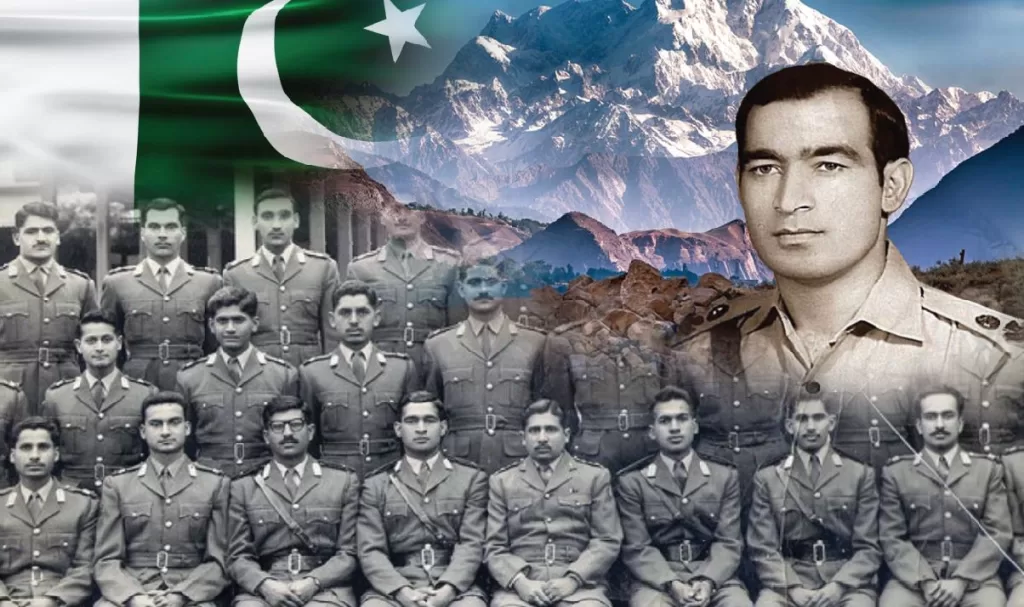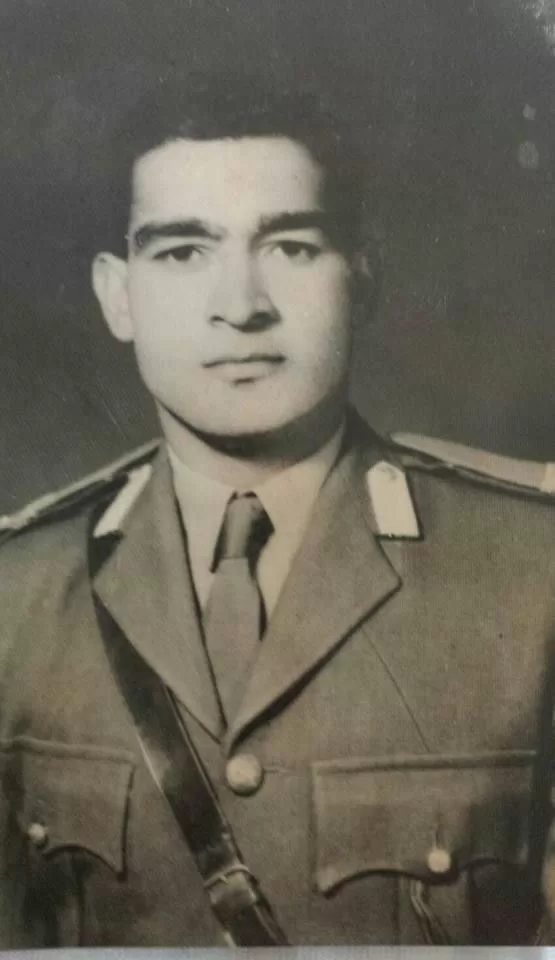Born on Dec 6, 1939 in Hazaribagh (India), one of seven brothers and four sisters, Sabir Kamal Meyer was educated at the prestigious Col Brown School in Dehradun alongwith his brothers. Their father, Sher Mohammad Meyer, was a businessman who provided logistical support to the Allied Armies in India but the partition of the subcontinent threw up daunting challenges, and fearing for his life and for his family’s safety, Sher Mohammad Meyer moved to Pakistan. Settling down in Murree, he provided the best education for his children; his sons were enrolled at the Lawrence College Ghora Galli (GG) and his daughters at a prestigious convent. At GG Sabir Kamal proved to be an excellent sportsman, setting the high jump record by clearing a height of 5ft and 10 inches and another record for throwing the discus; later, when he was in the Army, he set a record for the Commonwealth Military Games by clearing a height of 6 feet in the High Jump. He was also a good cricket, hockey and football player. Our families in Sialkot were very close to each other. Moreover, his elder brother, late Col Saeed Kamal Meyer, was from my unit, handpicked by my father, late Col AM Sehgal former Co 2E Bengal, because of our family association. I was always referred by the Meyers who were in GG with me as a “cousin”. I had the honour of being “Tuggy’s” (Saeed’s nickname) best man at his marriage to Saeeda Bhabi in Jhelum and while stationed in Mangla in 1969 “delivering” a flower bouquet by air from an L-19 to match that having carried flowers for his best friend Jeff’s proposal to Shahnaz Bhabi in Pindi from Lahore in Feb 1968.
Graduating from the PMA in 1962 Maj Sabir Kamal Meyer Shaheed had an illustrious military career, joining 10 FF (Frontier Force). Posted to 13 FF on February 25, 1969 in Sialkot, the battalion was ordered to East Pakistan, where safeguarded the Dacca Cantonment and its vital airport. He also ensured security of the cantonment and repelled numerous attacks. From April 1971 to Dec 1971 Maj Sabir commanded a Rifle Company and in constant action in East Pakistan, being awarded his first Sitara-i-Jurat (SJ) while clearing rebel opposition at Paksey Bridge on 11 Apr 1971. The SJ (Star of Courage) is Pakistan’s third highest military award and is awarded for gallantry or distinguished service in combat. During the Indo-Pakistani War of 1971 the Battle of Hilli is generally regarded as the most pitched battle between 23 Nov 1971 and 11 Dec 1971. The Area of Responsibility (AOR) was entrusted to 205 Brig led by Brig (later retired as Maj Gen) Tajammul Hussain Malik. Maj Sabir Kamal Meyer Shaheed along with Maj M Akram Shaheed (awarded Nishan e Haider) fought gallantly till both embraced Shahadat. Refusing to surrender against heavy odds, Maj Sabir Kamal Meyer kept fighting, exhorting his men to keep fighting, saying the Indians would take over and enter Hilli only over his dead body. Hit by an enemy tank shell in his chest this courageous soldier died on the spot. Laying down his life alongwith most of his men he succeeded in considerably slowing and halting the enemy’s advance. For his actions of valour and his dedication to duty, he was again awarded Sitara e Jurat (posthumously) on 8 Dec 1971, thus becoming the only soldier in Pakistan Army to be twice decorated for bravery with SJs in the same war. Between the two SJs he had got married in Spain where the bride’s father was serving as the Pakistani Ambassador.
Established in 1860, Lawrence College has a long and extensive history that should boast a distinguished roster of alumni covering politics, bureaucracy, military service, civil society and the corporate and business world. Some of the notable names include former Prime Ministers of Pakistan Shahid Khaqan Abbasi and Mir Zafarullah Khan Jamali, politicians such as Mumtaz Bhutto from Sindh, Aftab Ahmed Khan Sherpao from Khyber Pakhtunkhwa, Sarfraz Bugti from Balochistan, etc. Many other very prominent individuals are associated with the college. A small British cemetery within the premises is a solemn reminder of soldiers from India and Pakistan who made the ultimate sacrifice during World War II. Named after Sir Henry Montgomery Lawrence, a distinguished British soldier and statesman, the College is the oldest residential institution of its type in Pakistan. A public school on the pattern of the well-known public schools of the world, it is situated in Murree, at the beautiful foothills of the Himalayas. With its history of 160 years, Lawrence College is an institution with a distinctive character and glorious traditions in the fields of academics, and extra-curricular activities created by its pupils, popularly known as ‘Gallians’. The mission is to create a very conducive environment for educational excellence that prepares and grooms students academically, morally, physically and socially to compete and contribute in the society.
The ‘House System’ came into being in the 1920’s where each house was named after former British Principals and Governors of the Punjab e.g. Peake, Dane, Walker, Godley, Wightwick, O’ Dwyer, Maclagan and Wright. At the very core of boarding school life at Ghora Gali these Houses provide a sense of belonging and identity and promote a healthy, competitive, and non-adversarial environment and spirit. They also build a foundation of team work. Clear policies are published on all disciplinary matters, and are enforced firmly but fairly. However, while keeping the name “Lawrence College” we need to change back to our own Pakistani heroes and personalities as far as names of the “Houses” are concerned the British names have no meaning for us. Sabir was among those Gallians I have hero- worshipped as ideals, Brig Asmat Beg, Capt Zaheerul Islam Afridi Shaheed (1965), Brig Z A Khan, Brig Jafar Khan, Brig Rao Abid Hameed, Col Mahmood Nawaz, Col Saeed Kamal Meyer, Maj Gen Inayetullah Khan Niazi. Each one was outstanding in his own way. One of the most prestigious learning centers, Lawrence College prepares students for the Secondary School Certificate (Matriculation) and Higher Secondary School Certificate (Intermediate). Examinations are conducted by the Board of Intermediate and Secondary Education, Rawalpindi, and “O” Level Examination of the Cambridge University. Subjects on Science are taught only at the SSC level while in Intermediate the boys are prepared in Pre-Medical, Pre-Engineering and General Science groups including Computer Science. Fortnightly tests are as essential part of the college as are its three examinations, i.e. 1st Term, Mid Term and the Annual. The results of the examinations together with the Housemaster’s and the Principal’s reports are conveyed to the parents/guardians. Poor performance of boys in the periodic tests is also conveyed to the parents/guardians to keep them apprised of their son’s /ward’s attitude towards studies. Parent-teacher meetings are also arranged after the Mid-Term Examination to have a tripartite co-ordination for the improvement of the pupil’s efficiency. Regularly holding an Annual Alumni Reunion provides a very special and memorable occasion for former students to meet and share their memories at this institution. Alumni not only connect and reminisce, it also offers the college administration a unique opportunity to engage with alumni who may be on the college’s welfare. After the brutal terrorist act on the APS School Peshawar for me it was an honour and privilege for SMS to provide a dozen special guards FREE OF COST to augment GG’s own security even now nearly 10 years later. SMS continues to conduct GG’s security personnel regular training in batches in our Training School Islamabad. Two of my two heroes served in Pathfinder Group, Brig ZA Khan for nearly 6 years and Brig Asmat Beg for over 30 years till he died, Pathfinder Group contributed towards the Clock Tower in their name.

Like the Alam brothers the Meyer family has left a lasting impact on Lawrence College spanning several decades starting from the 1940s to the 1990s. Sabir Kamal Meyer’s friends at Lawrence College remember him with deep affection, recalling him as a soft spoken individual with a kind heart who would treat everyone with respect. Sabir Shaheed gave the ultimate sacrifice on the battlefield fighting against the enemy. Instead of the second SJ, Sabir more than deserved a Nishan-e-Haider. One humbly requests the present military hierarchy to re-visit the Hilli battle and correct this glaring omission in recognizing this brave son of the soil for what he really was, a true hero for the ages deserving Nishan-e-Haider in all senses of the word.
To die a martyr in Islam is one of the greatest of honours, to dies with selfless courage one must be given the true reward. The rewards granted are so sublime and are superior to the rewards for performing almost any other righteous act.
Think not of those who are slain in Allah’s way as dead. Nay, they live finding their sustenance in the presence of their Lord. (Surah al Imraan 3:169).




